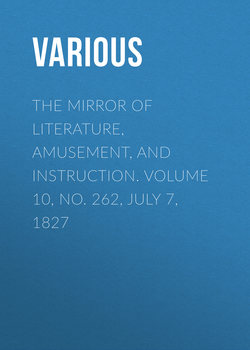Читать книгу The Mirror of Literature, Amusement, and Instruction. Volume 10, No. 262, July 7, 1827 - Various - Страница 4
PAY OF THE JUDGES IN FORMER TIMES
Оглавление(For the Mirror.)
In the twenty-third year of the reign of king Henry III., the salary of the justices of the bench (now called the Common Pleas) was 20l. per annum; in the forty-third year, 40l. In the twenty-seventh year, the chief baron had 40 marks; the other barons, 20 marks; and in the forty, ninth year, 4l. per annum. The justices coram rege (now called the King's Bench) had in the forty-third year of Henry III. 40l. per annum.; the chief of the bench, 100 marks per annum; and next year, another chief of the same court, had 100l.; but the chief of the court coram rege had only 100 marks per annum.
In the reign of Edward I., the salaries of the justices were very uncertain, and, upon the whole, they sunk from what they had been in the reign of Henry III. The chief justice of the bench, in the seventh year of Edward I., had but 40l. per annum, and the other justices there, 40 marks. This continued the proportion in both benches till the twenty-fifth year of Edward III., then the salary of the chief of the King's Bench fell to 50 marks, or 33l. 6s. 8d., while that of the chief of the bench was augmented to 100 marks, which may be considered as an evidence of the increase of business and attendance there. The chief baron had 40l.; the salaries of the other justices and barons were reduced to 20l.
In the reign of Edward II., the number of suitors so increased in the common bench, that whereas there had usually been only three justices there, that prince, at the beginning of his reign, was constrained to increase them to six, who used to sit in two places,—a circumstance not easy to be accounted for. Within three years after they were increased to seven; next year they were reduced to six, at which number they continued.
The salaries of the judges, though they had continued the same from the time of Edward I. to the twenty-fifth year of Edward III., were become very uncertain. In the twenty-eighth year of this king, it appears, that one of the justices of the King's Bench had 80 marks per annum. In the thirty-ninth year of Edward III. the judges had in that court 40l.; the same as the justices of the Common Pleas; but the chief of the King's Bench, 100 marks.
The salaries of the judges in the time of Henry IV. were as follows:—The chief baron, and other barons, had 40 marks per annum; the chief of the King's Bench, and of the Common Pleas, 40l. per annum; the other justices, in either court, 40 marks. But the gains of the practisers were become so great, that they could hardly be tempted to accept a place on the bench with such low salaries; therefore in the eighteenth year of Henry VI. the judges of all the courts at Westminster, together with the king's attorney and sergeants, exhibited a petition to parliament concerning the regular payment of their salaries and perquisites of robes. The king assented to their request, and order was taken for increasing their income, which afterwards became larger, and more fixed; this consisted of a salary and an allowance for robes. In the first year of Edward IV., the chief justice of the King's Bench had 170 marks per annum, 5l. 6s. 6d. for his winter robes, and the same for his Whitsuntide robes. Most of the judges had the honour of knighthood; some of them were knights bannerets; and some had the order of the Bath.
In the first year of Henry VII. the chief justice of the court of King's Bench had the yearly fee of 140 marks granted to him for his better support; he had besides 5l. 6s. 11-1/4 d., and the sixth part of a halfpenny (such is the accuracy of Sir William Dugdale, and the strangeness of the sum,) for his winter robes, and 3l. 6s. 6d. for his robes at Whitsuntide.
In the thirty-seventh year of Henry VIII. a further increase was made to the fees of the judges;—to the chief justice of the King's Bench 30l. per annum; to every other justice of that court 20l. per annum; to every justice of the Common Pleas, 20l. per annum.
There were usually in the court of Common Pleas five judges, sometimes six; and in the reign of Henry VI. there were, it is said, eight judges at one time in that court; but six appear to have been the regular number. In the King's Bench there were sometimes four, sometimes five. They did not sit above three hours a day in court,—from eight in the morning to eleven. The courts were not open in the afternoon; but that time was left unoccupied for suitors to confer with their counsel at home.
F. R. Y.
